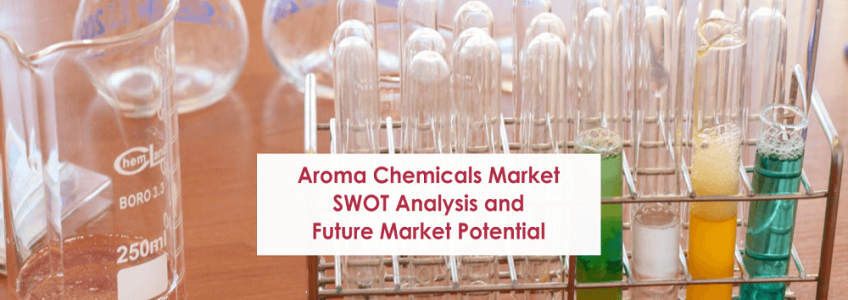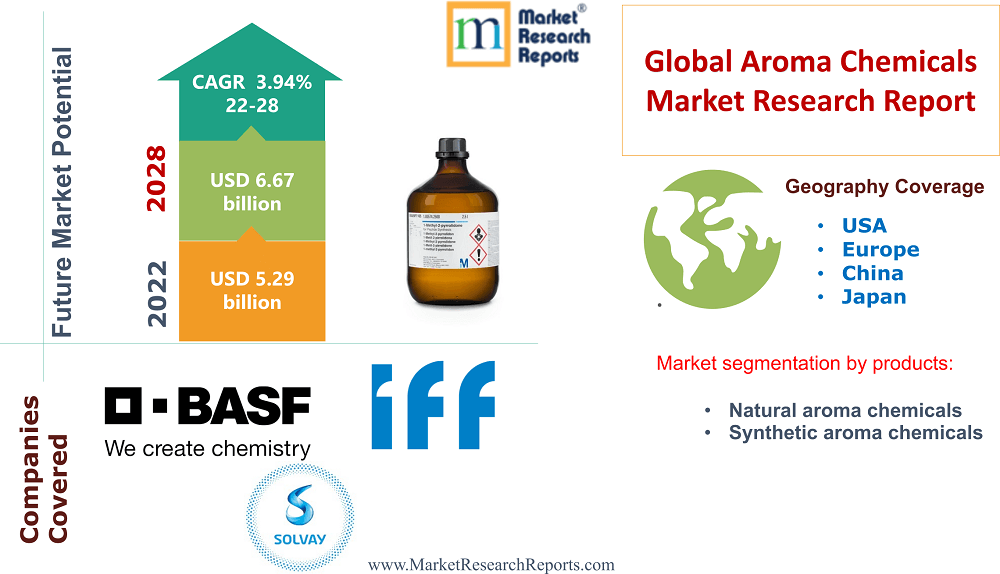Aroma Chemicals Market SWOT Analysis and Future Market Potential

The aroma chemicals industry is a growing market that offers many opportunities for companies that produce and use these chemicals. Aromas are used in a wide range of products, including fragrances for personal care and household products, as well as in food and beverages. This industry is driven by consumer demand for products with pleasant smells and the increasing popularity of natural and organic products.
1 . Aroma Chemicals Manufacturing Process
- Synthesis: The first step in the manufacturing process is to synthesize the raw materials, which typically include petrochemicals or natural compounds. This is done through a chemical reaction in a laboratory setting, where the desired aroma chemical is created.
- Distillation: After synthesis, the aroma chemical is distilled to remove impurities and isolate the pure compound. This is done through a process of heating and cooling, where the aroma chemical is vaporized and then condensed back into a liquid form.
- Purification: Once the aroma chemical has been distilled, it is further purified through a series of processes such as filtration, crystallization, and chromatography. This ensures that the final product is of high purity and is ready for use in fragrances and other scented products.
- Blending: The final step in the manufacturing process is to blend the purified aroma chemical with other ingredients to create the desired scent profile. This can involve mixing different aroma chemicals, as well as adding carrier oils and other ingredients to create the desired fragrance.
2 . Aroma Chemicals Market Scenario
3 . Types of Aroma Chemicals
- Natural aroma chemicals are derived from natural sources, such as plants, animals, and minerals. These chemicals are extracted and isolated through various processes, such as distillation, extraction, and enfleurage.
- Synthetic aroma chemicals, on the other hand, are those that are artificially created in a laboratory. These chemicals are synthesized from various raw materials, such as petrochemicals, through chemical reactions.
Reports Suggested for Aroma Chemical Marketers/Manufacturers
- Aroma Chemicals Market Research Reports
- Synthetic Aroma Chemicals Market Research Reports
- Natural Aroma Chemicals Market Research Reports
- Fragrances Market Research Reports
4 . Application of Aroma Chemicals in Various Industries
- Food and beverage industry: Vanilla, citrus, mint, and other fruit and spice aromas are commonly used in this industry for flavoring and enhancing the appeal of various products.
- Cosmetics and personal care industry: Aromas such as rose, lavender, jasmine, and sandalwood are commonly used in products such as perfumes, body care products, and shampoos.
- Household cleaning industry: Aromas such as lemon, pine, and lavender are commonly used in cleaning products to mask unpleasant odors and to provide a pleasant scent.
- Pharmaceutical industry: Aromas such as menthol and eucalyptus are commonly used in cold and cough medications and nasal sprays.
- Tobacco industry: Aromas such as vanilla, cherry, and chocolate are commonly added to cigarettes and other tobacco products to enhance flavor and appeal.
- Home fragrances: Aromas such as lavender, vanilla, and citrus are commonly used in scented candles, diffusers, and other home fragrance products to provide a pleasant and relaxing atmosphere in the home.
5 . SWOT Analysis of the Aroma Chemical Market
- Wide range of applications in various industries, including food and beverages, cosmetics, and perfumes.
- Increasing demand for natural and organic aroma chemicals.
- Advancements in technology leading to the development of new and improved aroma chemicals.
- Strong presence of major players in the market.
- High cost of production and low availability of raw materials.
- Stringent regulations regarding the use of synthetic aroma chemicals.
- Lack of awareness among consumers about the potential health risks associated with synthetic aroma chemicals.
- Growing demand for natural and organic products in the food and beverage industry.
- Increasing demand for personal care and cosmetics products in emerging economies.
- Opportunities for new players to enter the market through the development of innovative and eco-friendly aroma chemicals.
- Threat of substitute products, such as essential oils and natural extracts.
- Increasing competition from emerging economies, such as China and India.
- Fluctuations in raw material prices and supply.
- Rising environmental concerns and stricter regulations on the use of synthetic aroma chemicals.
6 . Leading Aroma Chemical Products
- Benzaldehyde - a sweet, almond-like aroma often used in confectionery and perfume products.
- Benzyl acetate - used in perfumes and flavors for its sweet, floral aroma
- Citral - a citrusy aroma commonly used in perfumes and fragrances.
- Cinnamaldehyde - the main component of cinnamon flavor, used in a range of food and beverage products.
- Citronellol - used in fragrances and perfumes for its rose-like scent
- Ethyl vanillin - used in food and beverages for its vanilla aroma
- Ethyl maltol - used in flavors and fragrances for its sweet, caramel-like scent.
- Geraniol - a floral aroma commonly used in perfumes and fragrances.
- Isobutyl acetate - a fruity, sweet aroma used in a range of flavors and fragrances.
- Limonene - a citrusy aroma commonly used in cleaning products and perfumes.
- Linalool - a floral aroma commonly used in perfumes and soaps.
- Methyl salicylate - a sweet, wintergreen aroma used in various fragrances and flavors.
- Phenyl ethyl alcohol - a sweet, floral aroma used in perfumes and fragrances.
- Vanillin - used in food and beverages for its vanilla aroma
7 . Aroma Chemical Market Leaders
- Givaudan: Company is a leading global provider of aromatic chemical products, including fragrances and flavors, for a wide range of consumer and industrial applications. The company was founded in 1796 and has a long history of innovation in the industry. With a team of expert perfumers and flavorists, Givaudan creates unique and custom solutions for its customers, using natural and synthetic ingredients sourced from around the world. In addition to its core products, the company also offers a range of services, including sensory evaluation, consumer research, and technical support.
- International Flavors & Fragrances (IFF): IFF is a leading global producer of aromatic chemical products used in the food, beverage, and consumer products industries. IFF's portfolio includes a wide range of flavors, fragrances, and specialty ingredients that are used to enhance the sensory experiences of consumers.
- BASF is a German multinational chemical company. They produce a wide range of chemicals, including aromatic chemicals, which are compounds that contain one or more aromatic rings. These rings are made up of carbon atoms bonded in a specific arrangement, and they are known for their distinct, pleasant odor. Aromatic chemicals are used in a variety of products, including perfumes, flavors, and fragrances.
- Firmenich is a leading global producer of aromatic chemicals, which are used in a variety of industries, including perfumery, food and beverage, and household products. Some of their most popular aromatic chemicals include essential oils, natural extracts, and synthetic molecules. These ingredients are carefully sourced and crafted to deliver the desired sensory experience in a wide range of applications.
- Solvay Aromatics is a division of the Belgian chemical company Solvay that specializes in the production of aromatic chemicals. These are chemicals that have a strong, pleasant aroma and are commonly used in the fragrance and flavor industry. Examples of Solvay Aromatics products include benzaldehyde, cinnamic acid, and phenylacetic acid.
- Takasago International Corporation is a leading global manufacturer and supplier of aromatic chemicals for use in a variety of industries, including food and beverage, fragrances, and household products. The company has a wide range of aromatic chemicals, including natural essential oils, synthetic fragrances, and aroma chemicals.
Reports Suggested for Aroma Chemical Manufacturers
- Global Natural Benzaldehyde Market Insights
- Global Benzyl Acetate Market Insights
- Global Cinnamaldehyde Market Insights
- Global Limonene Market Insights and Forecast
- Global Phenyl Ethyl Alcohol Market Insights and Forecast






